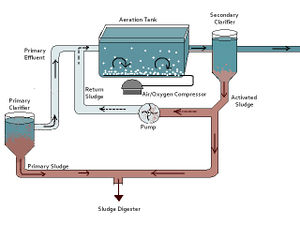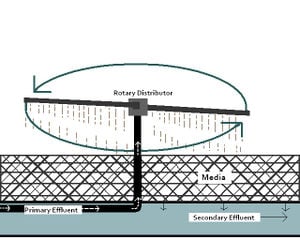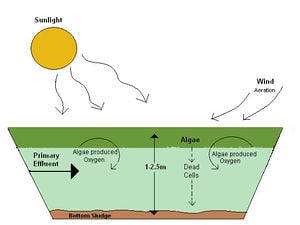No edit summary |
Anonymous1 (talk | contribs) No edit summary |
||
| Line 2: | Line 2: | ||
{{TOCright}} | {{TOCright}} | ||
= Introduction= | = Introduction= | ||
[[Wastewater treatment]] is critical in maintaining the quality of water. Wastewater exits residential, business, and industry buildings via drains; this includes water from toilets, washer machines, dish washers, showers, and baths. The water is transported to local wastewater treatment facilities and undergoes a series of treatments in order to remove pollutants that would | [[Wastewater treatment]] is critical in maintaining the quality of water. Wastewater exits residential, business, and industry buildings via drains; this includes water from toilets, washer machines, dish washers, showers, and baths. The water is transported to local wastewater treatment facilities and undergoes a series of treatments in order to remove pollutants that would otherwise pollute the environment. | ||
==Brief History== | ==Brief History== | ||
In response to the escalating pollution of natural bodies of water, the Federal Government endorsed the Clean Water Act [http://www.epa.gov/watertrain/cwa/] in 1972. This act required that wastewater treatment plants operate with a secondary treatment system. The systems are designed to remove pollutants that generally would be released into a natural body of water, such as, lakes, rivers, and bays. | In response to the escalating pollution of natural bodies of water, the Federal Government endorsed the Clean Water Act [http://www.epa.gov/watertrain/cwa/] in 1972. This act required that wastewater treatment plants operate with a secondary treatment system. The systems are designed to remove pollutants that generally would be released into a natural body of water, such as, lakes, rivers, and bays. | ||
==Brief Explanation== | ==Brief Explanation== | ||
Once wastewater has gone through the [[primary treatment]] stage the [[effluent]] will undergo a secondary treatment in order to remove both small suspended solids and BOD<sub>5</sub>(five day biochemical oxygen demand[http://www.websters-online-dictionary.org/BO/BOD5.html]) that pass through the primary treatment stage. All secondary treatment systems use a biological process to break down organic matter; the use of microorganisms to consume organic matter and oxygen delivery to ensure microorganism survival. | Once wastewater has gone through the [[primary treatment]] stage the [[effluent]] will undergo a secondary treatment in order to remove both small suspended solids and BOD<sub>5</sub>(five day biochemical oxygen demand[http://www.websters-online-dictionary.org/BO/BOD5.html]) that pass through the primary treatment stage. All secondary treatment systems use a biological process to break down organic matter; the use of [[microorganisms]] to consume organic matter and oxygen delivery to ensure microorganism survival. Oxygen delivery differs among the various systems. The biological process that occurs naturally in nature is accelerated in the treatment system. Secondary treatment will typically remove 85% of BOD and suspended solids <ref>avis, Mackenzie L., Masten, Susan J. (2004) Principles of Environmental Engineering and Science New York, McGraw-Hill</ref>. Water exiting secondary treatment will still carry nitrogen, phosphorus, heavy metals, pathogens, and bacteria. For further removal of pollutants the water is transported to a tertiary treatment[http://www.aqua-enviro.net/pdf/Example%20paper.pdf] system and disinfection. | ||
There are a variety of secondary treatment | There are a variety of secondary treatment processes; the following are conventional processes used by treatment plants: | ||
*Activated sludge | *Activated sludge | ||
*Trickling filter | *Trickling filter | ||
*Oxidation ponds | *Oxidation ponds | ||
There are pros and cons to each of these three processes. Operational and initial | There are pros and cons to each of these three processes. Operational and initial costs along with space are three factors that will often determine which technique is appropriate. Space is influenced by population size and cost of land. For example, oxidation ponds require large areas of land if land is costly or needed for housing oxidation ponds are not a likely option. Additionally wastewater treatment plants need to consider maintenance, reliability, and effectiveness of the system. | ||
=Activated Sludge= | =Activated Sludge= | ||
[[Image:Improved_AS.jpg|thumb|right|Fig 1: Active Sludge]] | [[Image:Improved_AS.jpg|thumb|right|Fig 1: Active Sludge]] | ||
'''Process:''' | '''Process:''' | ||
During the activated sludge process primary effluent flows into an aeration tank, where it is mixed with microorganisms . The aeration tank injects a steady supply of oxygen or air into the wastewater, ensuring that the organisms have an adequate supply of oxygen needed to breakdown the organic matter that remains in the effluent. The effluent then flows into secondary settling tanks. At this point the sludge goes in | During the activated sludge process primary effluent flows into an aeration tank, where it is mixed with microorganisms. The aeration tank injects a steady supply of oxygen or air into the wastewater, ensuring that the organisms have an adequate supply of oxygen needed to breakdown the organic matter that remains in the effluent. The effluent then flows into secondary settling tanks. At this point the sludge goes in one of two directions; 1. back to the aeration tank, this is because the return sludge contains a large amount of microorganisms that will rapidly breakdown organic matter, or 2. to the sludge digester[http://www.daviddarling.info/encyclopedia/A/AE_anaerobic_digestion.html]. The treated water will enter the tertiary treatment stage; here it will go through the final treatment stage before it is released into a natural water system. Figure 1 is an example an active sludge system. | ||
<br />'''Pros:''' | <br />'''Pros:''' | ||
#Low construction cost | #Low construction cost | ||
| Line 27: | Line 27: | ||
[[Image:Trickling_Filter.jpg|thumb|right|Fig 2: Trickling filter]] | [[Image:Trickling_Filter.jpg|thumb|right|Fig 2: Trickling filter]] | ||
'''Process:''' | '''Process:''' | ||
When primary effluent is transported to a trickling filter system the wastewater is dispensed upon a bed of media, such as rocks, stones, plastics, or salts. The effluent flows through the material at | When primary effluent is transported to a trickling filter system the wastewater is dispensed upon a bed of media, such as rocks, stones, plastics, or salts. The effluent flows through the material at slow enough rates to allow microbial growth on the surface of the media creating a layer of film. The spacing of the media allows air to circulate throughout the trickling system. Once microbial growth takes place additional wastewater flow has contact with microorganisms; this contact ensures that the organic matter in the primary effluent is broken down. The film that flows through the bed of material will be transported to the secondary settling tank to prevent excess microorganisms. The secondary effluent that settles will either enter a digester or re-enter the trickling system. Secondary effluent that re-enters the trickling filter serves several purposes, the following are examples; 1. further treatment, 2. preventing the microorganism from drying out, and 3. diluting or supplementing primary effluent. Figure 2 provides a visual layout of a trickling filter system. | ||
<br />'''Pros:''' | <br />'''Pros:''' | ||
#Low construction cost | #Low construction cost | ||
| Line 39: | Line 39: | ||
[[Image:Oxidation_Pond.jpg|thumb|right|Fig 3: Oxidation pond]] | [[Image:Oxidation_Pond.jpg|thumb|right|Fig 3: Oxidation pond]] | ||
'''Process:''' | '''Process:''' | ||
Oxidation ponds are large and shallow; a typical depth would range from 1-2.5m. The ponds are composed of microorganisms, which feed on the organic matter received from primary effluent. Algae are a key figure in the oxidation pond system. Algae are much like the aeration tank in the activated sludge system; they deliver a steady flow of oxygen. The algae requires sunlight to produce oxygen via photosynthesis, reaeration created by wind delivers air flow when sunlight is not available. Overall the process is slow and requires large areas of land. Typically oxidation ponds are used in areas with small populations where land is readily available. Figure 3 | Oxidation ponds are large and shallow; a typical depth would range from 1-2.5m. The ponds are composed of microorganisms, which feed on the organic matter received from primary effluent. Algae are a key figure in the oxidation pond system. Algae are much like the aeration tank in the activated sludge system; they deliver a steady flow of oxygen. The algae requires sunlight to produce oxygen via photosynthesis, reaeration created by wind delivers air flow when sunlight is not available. Overall the process is slow and requires large areas of land. Typically oxidation ponds are used in areas with small populations where land is readily available. Figure 3 shows the basics of an oxidation pond system. | ||
<br />'''Pros:''' | <br />'''Pros:''' | ||
#Small energy input | #Small energy input | ||
Revision as of 20:23, 9 May 2008
Introduction
Wastewater treatment is critical in maintaining the quality of water. Wastewater exits residential, business, and industry buildings via drains; this includes water from toilets, washer machines, dish washers, showers, and baths. The water is transported to local wastewater treatment facilities and undergoes a series of treatments in order to remove pollutants that would otherwise pollute the environment.
Brief History
In response to the escalating pollution of natural bodies of water, the Federal Government endorsed the Clean Water Act [1] in 1972. This act required that wastewater treatment plants operate with a secondary treatment system. The systems are designed to remove pollutants that generally would be released into a natural body of water, such as, lakes, rivers, and bays.
Brief Explanation
Once wastewater has gone through the primary treatment stage the effluent will undergo a secondary treatment in order to remove both small suspended solids and BOD5(five day biochemical oxygen demand[2]) that pass through the primary treatment stage. All secondary treatment systems use a biological process to break down organic matter; the use of microorganisms to consume organic matter and oxygen delivery to ensure microorganism survival. Oxygen delivery differs among the various systems. The biological process that occurs naturally in nature is accelerated in the treatment system. Secondary treatment will typically remove 85% of BOD and suspended solids [1]. Water exiting secondary treatment will still carry nitrogen, phosphorus, heavy metals, pathogens, and bacteria. For further removal of pollutants the water is transported to a tertiary treatment[3] system and disinfection. There are a variety of secondary treatment processes; the following are conventional processes used by treatment plants:
- Activated sludge
- Trickling filter
- Oxidation ponds
There are pros and cons to each of these three processes. Operational and initial costs along with space are three factors that will often determine which technique is appropriate. Space is influenced by population size and cost of land. For example, oxidation ponds require large areas of land if land is costly or needed for housing oxidation ponds are not a likely option. Additionally wastewater treatment plants need to consider maintenance, reliability, and effectiveness of the system.
Activated Sludge

Process:
During the activated sludge process primary effluent flows into an aeration tank, where it is mixed with microorganisms. The aeration tank injects a steady supply of oxygen or air into the wastewater, ensuring that the organisms have an adequate supply of oxygen needed to breakdown the organic matter that remains in the effluent. The effluent then flows into secondary settling tanks. At this point the sludge goes in one of two directions; 1. back to the aeration tank, this is because the return sludge contains a large amount of microorganisms that will rapidly breakdown organic matter, or 2. to the sludge digester[4]. The treated water will enter the tertiary treatment stage; here it will go through the final treatment stage before it is released into a natural water system. Figure 1 is an example an active sludge system.
Pros:
- Low construction cost
- Occupies small area
- Relatively low odor
- Removes a high percent of BOD
Cons:
- High operating cost (air pumps)
- High energy expenses for oxygen demand
Trickling Filter

Process:
When primary effluent is transported to a trickling filter system the wastewater is dispensed upon a bed of media, such as rocks, stones, plastics, or salts. The effluent flows through the material at slow enough rates to allow microbial growth on the surface of the media creating a layer of film. The spacing of the media allows air to circulate throughout the trickling system. Once microbial growth takes place additional wastewater flow has contact with microorganisms; this contact ensures that the organic matter in the primary effluent is broken down. The film that flows through the bed of material will be transported to the secondary settling tank to prevent excess microorganisms. The secondary effluent that settles will either enter a digester or re-enter the trickling system. Secondary effluent that re-enters the trickling filter serves several purposes, the following are examples; 1. further treatment, 2. preventing the microorganism from drying out, and 3. diluting or supplementing primary effluent. Figure 2 provides a visual layout of a trickling filter system.
Pros:
- Low construction cost
- Straightforward system
Cons:
- Temperature Dependent
- Vulnerable to congestion, which can lead to flooding and system failure, low oxygen supply, and restricted water flow
- Occupies a large area
- High Maintenance
Oxidation Ponds

Process:
Oxidation ponds are large and shallow; a typical depth would range from 1-2.5m. The ponds are composed of microorganisms, which feed on the organic matter received from primary effluent. Algae are a key figure in the oxidation pond system. Algae are much like the aeration tank in the activated sludge system; they deliver a steady flow of oxygen. The algae requires sunlight to produce oxygen via photosynthesis, reaeration created by wind delivers air flow when sunlight is not available. Overall the process is slow and requires large areas of land. Typically oxidation ponds are used in areas with small populations where land is readily available. Figure 3 shows the basics of an oxidation pond system.
Pros:
- Small energy input
- Degrades Nitrogen and Phosphorus
Cons:
- Occupies a large area
- Possible odors
- Slow process
- Long retention times
- Climate dependent
Conclusion
Links
- Clean Water Act - US EPA
- [5]-An Overview of Tertiary Treatment
- [6]-Anaerobic Digestion
- [7]-Websters definition of BOD
References
- ↑ avis, Mackenzie L., Masten, Susan J. (2004) Principles of Environmental Engineering and Science New York, McGraw-Hill